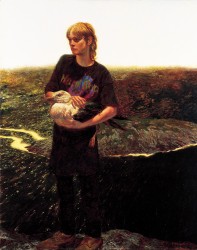Timelessness in Art
You can often overhear interesting things in art museums and galleries. On the last day of “The Wyeths: America’s Artists” at the Kalamazoo Institute of Arts, a man standing one painting to our left said with a semi-sour look, “The mullet kind of dates it”; he was looking at Jamie Wyeth’s “Portrait of Orca Bates”, and I think he mostly missed the point – but I’ll get to that.
Timelessness is one of those art terms that, if you frequent artsy circles, you will regularly hear thrown around. You will most often hear it used in a context of either praise or derision; it’s one of those art terms. Andrew Wyeth is known to have said that he liked painting nudes because of the timeless quality of the picture; I think maybe depicting a nude in front of some sort of amorphous background is the only way a figurative painting might be considered timeless (in the sense of the art term, at least), and even then, hair styles may be a giveaway to the time period.
Because we only have the personal experience of our own time, I think it is much easier to see images from the past as having a timeless quality. What we’re really seeing is unfamiliarity, out-of-our-own-timeness, not timelessness. Old stuff – frilly clothing, long bygone hair styles, antique personal accouterments, horses, ragged wooden shacks – always has a way of seeming classical, timeless. Maybe in a few generations, a mullet, a gold stud earring, battered work boots, and a Hard Rock Cafe t-shirt will be classical too; we just can’t see it right now. Personally, I don’t really care, it’s a beautifully expressive painting.
Maybe the real questions are: Does it matter? Are we getting the point?
I don’t think timelessness really matters.
First, pure timelessness is very rare.
Second, our enjoyment and understanding of a painting shouldn’t be swayed by critical art-world terminology.
Third, art is better understood when taken in the context of the artist’s time period and personality, and the Wyeths are no exception to this. Andrew and Jamie are known for distilling the essence of their experiences, surroundings, and imaginations in their paintings. It is this very observation and recording of their intimate universe coupled with a willingness to externalize their hearts and minds that makes their art so great – so full of meaning and emotion. When we begin to engage with all the possible stories behind their images, when we begin to understand and have a feeling for the artist’s intent, they only become deeper.